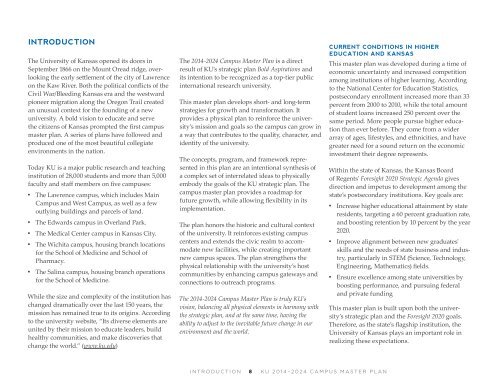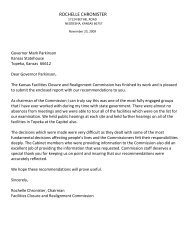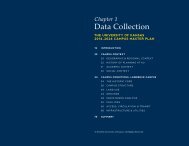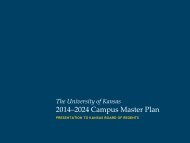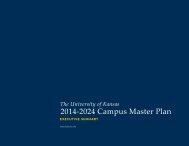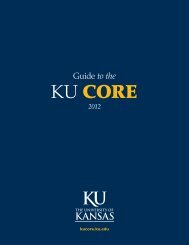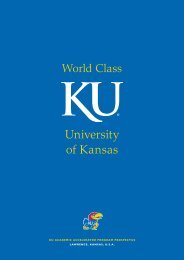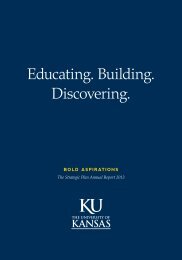KU_Chapter00_Introduction_2014-06-10
KU_Chapter00_Introduction_2014-06-10.pdf
KU_Chapter00_Introduction_2014-06-10.pdf
Create successful ePaper yourself
Turn your PDF publications into a flip-book with our unique Google optimized e-Paper software.
INTRODUCTION<br />
The University of Kansas opened its doors in<br />
September 1866 on the Mount Oread ridge, overlooking<br />
the early settlement of the city of Lawrence<br />
on the Kaw River. Both the political conflicts of the<br />
Civil War/Bleeding Kansas era and the westward<br />
pioneer migration along the Oregon Trail created<br />
an unusual context for the founding of a new<br />
university. A bold vision to educate and serve<br />
the citizens of Kansas prompted the first campus<br />
master plan. A series of plans have followed and<br />
produced one of the most beautiful collegiate<br />
environments in the nation.<br />
Today <strong>KU</strong> is a major public research and teaching<br />
institution of 28,000 students and more than 5,000<br />
faculty and staff members on five campuses:<br />
••<br />
The Lawrence campus, which includes Main<br />
Campus and West Campus, as well as a few<br />
outlying buildings and parcels of land.<br />
••<br />
The Edwards campus in Overland Park.<br />
••<br />
The Medical Center campus in Kansas City.<br />
••<br />
The Wichita campus, housing branch locations<br />
for the School of Medicine and School of<br />
Pharmacy.<br />
••<br />
The Salina campus, housing branch operations<br />
for the School of Medicine.<br />
While the size and complexity of the institution has<br />
changed dramatically over the last 150 years, the<br />
mission has remained true to its origins. According<br />
to the university website, “Its diverse elements are<br />
united by their mission to educate leaders, build<br />
healthy communities, and make discoveries that<br />
change the world.” (www.ku.edu)<br />
The <strong>2014</strong>-2024 Campus Master Plan is a direct<br />
result of <strong>KU</strong>’s strategic plan Bold Aspirations and<br />
its intention to be recognized as a top-tier public<br />
international research university.<br />
This master plan develops short- and long-term<br />
strategies for growth and transformation. It<br />
provides a physical plan to reinforce the university’s<br />
mission and goals so the campus can grow in<br />
a way that contributes to the quality, character, and<br />
identity of the university.<br />
The concepts, program, and framework represented<br />
in this plan are an intentional synthesis of<br />
a complex set of interrelated ideas to physically<br />
embody the goals of the <strong>KU</strong> strategic plan. The<br />
campus master plan provides a roadmap for<br />
future growth, while allowing flexibility in its<br />
implementation.<br />
The plan honors the historic and cultural context<br />
of the university. It reinforces existing campus<br />
centers and extends the civic realm to accommodate<br />
new facilities, while creating important<br />
new campus spaces. The plan strengthens the<br />
physical relationship with the university’s host<br />
communities by enhancing campus gateways and<br />
connections to outreach programs.<br />
The <strong>2014</strong>-2024 Campus Master Plan is truly <strong>KU</strong>’s<br />
vision, balancing all physical elements in harmony with<br />
the strategic plan, and at the same time, having the<br />
ability to adjust to the inevitable future change in our<br />
environment and the world.<br />
CURRENT CONDITIONS IN HIGHER<br />
EDUCATION AND KANSAS<br />
This master plan was developed during a time of<br />
economic uncertainty and increased competition<br />
among institutions of higher learning. According<br />
to the National Center for Education Statistics,<br />
postsecondary enrollment increased more than 33<br />
percent from 2000 to 20<strong>10</strong>, while the total amount<br />
of student loans increased 250 percent over the<br />
same period. More people pursue higher education<br />
than ever before. They come from a wider<br />
array of ages, lifestyles, and ethnicities, and have<br />
greater need for a sound return on the economic<br />
investment their degree represents.<br />
Within the state of Kansas, the Kansas Board<br />
of Regents' Foresight 2020 Strategic Agenda gives<br />
direction and impetus to development among the<br />
state’s postsecondary institutions. Key goals are:<br />
••<br />
Increase higher educational attainment by state<br />
residents, targeting a 60 percent graduation rate,<br />
and boosting retention by <strong>10</strong> percent by the year<br />
2020.<br />
••<br />
Improve alignment between new graduates'<br />
skills and the needs of state business and industry,<br />
particularly in STEM (Science, Technology,<br />
Engineering, Mathematics) fields.<br />
••<br />
Ensure excellence among state universities by<br />
boosting performance, and pursuing federal<br />
and private funding<br />
This master plan is built upon both the university’s<br />
strategic plan and the Foresight 2020 goals.<br />
Therefore, as the state’s flagship institution, the<br />
University of Kansas plays an important role in<br />
realizing these expectations.<br />
INTRODUCTION<br />
8<br />
<strong>KU</strong> <strong>2014</strong>–2024 CAMPUS MASTER PLAN


